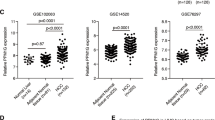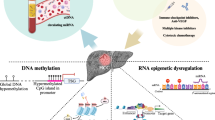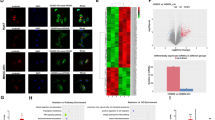Abstract
We have previously identified 1 241 regions of somatic copy number alterations (CNAs) in hepatocellular carcinoma (HCC). In the present study, we found that a novel recurrent focal amplicon, 1q24.1-24.2, targets the MPZL1 gene in HCC. Notably, there is a positive correlation between the expression levels of MPZL1 and intrahepatic metastasis of the HCC specimens. MPZL1 can significantly enhance the migratory and metastatic potential of the HCC cells. Moreover, we found that one of the mechanisms by which MPZL1 promotes HCC cell migration is by inducing the phosphorylation and activation of the pro-metastatic protein, cortactin. Additionally, we found that Src kinase mediates the phosphorylation and activation of cortactin induced by MPZL1 overexpression. Taken together, these findings suggest that MPZL1 is a novel pro-metastatic gene targeted by a recurrent region of copy number amplification at 1q24.1-24.2 in HCC.
Similar content being viewed by others
Log in or create a free account to read this content
Gain free access to this article, as well as selected content from this journal and more on nature.com
or
References
Lau SH, Sham JS, Xie D, et al. Clusterin plays an important role in hepatocellular carcinoma metastasis. Oncogene 2006; 25:1242–1250.
Yang JM, Peng ZH, Si SH, Liu WW, Luo YH, Ye ZY . KAI1 gene suppresses invasion and metastasis of hepatocellular carcinoma MHCC97-H cells in vitro and in animal models. Liver Int 2008; 28:132–139.
Wong CC, Wong CM, Tung EK, Man K, Ng IO . Rho-kinase 2 is frequently overexpressed in hepatocellular carcinoma and involved in tumor invasion. Hepatology 2009; 49:1583–1594.
Lee TK, Poon RT, Yuen AP et al. Twist overexpression correlates with hepatocellular carcinoma metastasis through induction of epithelial-mesenchymal transition. Clin Cancer Res 2006; 12:5369–5376.
Yao J, Liang L, Huang S et al. MicroRNA-30d promotes tumor invasion and metastasis by targeting Galphai2 in hepatocellular carcinoma. Hepatology 2010; 51:846–856.
Ding J, Huang S, Wu S et al. Gain of miR-151 on chromosome 8q24.3 facilitates tumour cell migration and spreading through downregulating RhoGDIA. Nat Cell Biol 2010; 12:390–399.
Ying Q, Liang L, Guo W et al. Hypoxia-inducible microRNA-210 augments the metastatic potential of tumor cells by targeting vacuole membrane protein 1 in hepatocellular carcinoma. Hepatology 2011; 54:2064–2075.
Whittaker S, Marais R, Zhu AX . The role of signaling pathways in the development and treatment of hepatocellular carcinoma. Oncogene 2010; 29:4989–5005.
Shlien A, Malkin D . Copy number variations and cancer susceptibility. Curr Opin Oncol 2010; 22:55–63.
Hahn WC, Dunn IF, Kim SY et al. Integrative genomic approaches to understanding cancer. Biochim Biophys Acta 2009; 1790:478–484.
Firestein R, Bass AJ, Kim SY et al. CDK8 is a colorectal cancer oncogene that regulates beta-catenin activity. Nature 2008; 455:547–551.
Jia D, Wei L, Guo W et al. Genome-wide copy number analyses identified novel cancer genes in hepatocellular carcinoma. Hepatology 2011; 54:1227–1236.
Sawey ET, Chanrion M, Cai C et al. Identification of a therapeutic strategy targeting amplified FGF19 in liver cancer by Oncogenomic screening. Cancer Cell 2011; 19:347–358.
Lau SH, Guan XY . Cytogenetic and molecular genetic alterations in hepatocellular carcinoma. Acta Pharmacol Sin 2005; 26:659–665.
Chen L, Chan TH, Guan XY . Chromosome 1q21 amplification and oncogenes in hepatocellular carcinoma. Acta Pharmacol Sin 2010; 31:1165–1171.
Ma NF, Hu L, Fung JM et al. Isolation and characterization of a novel oncogene, amplified in liver cancer 1, within a commonly amplified region at 1q21 in hepatocellular carcinoma. Hepatology 2008; 47:503–510.
Zannettino AC, Roubelakis M, Welldon KJ et al. Novel mesenchymal and haematopoietic cell isoforms of the SHP-2 docking receptor, PZR: identification, molecular cloning and effects on cell migration. Biochem J 2003; 370:537–549.
Roubelakis MG, Martin-Rendon E, Tsaknakis G, Stavropoulos A, Watt SM . The murine ortholog of the SHP-2 binding molecule, PZR accelerates cell migration on fibronectin and is expressed in early embryo formation. J Cell Biochem 2007; 102:955–969.
Eminaga S, Bennett AM . Noonan syndrome-associated SHP-2/Ptpn11 mutants enhance SIRPalpha and PZR tyrosyl phosphorylation and promote adhesion-mediated ERK activation. J Biol Chem 2008; 283:15328–15338.
Kusano K, Thomas TN, Fujiwara K . Phosphorylation and localization of protein-zero related (PZR) in cultured endothelial cells. Endothelium 2008; 15:127–136.
Roessler S, Jia HL, Budhu A et al. A unique metastasis gene signature enables prediction of tumor relapse in early-stage hepatocellular carcinoma patients. Cancer Res 2010; 70:10202–10212.
Chen X, Cheung ST, So S et al. Gene expression patterns in human liver cancers. Mol Biol Cell 2002; 13:1929–1939.
Cui JF, Liu YK, Zhang LJ et al. Identification of metastasis candidate proteins among HCC cell lines by comparative proteome and biological function analysis of S100A4 in metastasis in vitro. Proteomics 2006; 6:5953–5961.
Genda T, Sakamoto M, Ichida T et al. Cell motility mediated by rho and Rho-associated protein kinase plays a critical role in intrahepatic metastasis of human hepatocellular carcinoma. Hepatology 1999; 30:1027–1036.
Anderson K, Potter A, Baban D, Davies KE . Protein expression changes in spinal muscular atrophy revealed with a novel antibody array technology. Brain 2003; 126:2052–2064.
Huang GJ, Yang CM, Chang YS et al. Hispolon suppresses SK-Hep1 human hepatoma cell metastasis by inhibiting matrix metalloproteinase-2/9 and urokinase-plasminogen activator through the PI3K/Akt and ERK signaling pathways. J Agric Food Chem 2010; 58:9468–9475.
Kang S, Elf S, Lythgoe K et al. p90 ribosomal S6 kinase 2 promotes invasion and metastasis of human head and neck squamous cell carcinoma cells. J Clin Invest 2010; 120:1165–1177.
von Sengbusch A, Gassmann P, Fisch KM, Enns A, Nicolson GL, Haier J . Focal adhesion kinase regulates metastatic adhesion of carcinoma cells within liver sinusoids. Am J Pathol 2005; 166:585–596.
Summy JM, Gallick GE . Src family kinases in tumor progression and metastasis. Cancer Metastasis Rev 2003; 22:337–358.
Buday L, Downward J . Roles of cortactin in tumor pathogenesis. Biochim Biophys Acta 2007; 1775:263–273.
Yamada S, Yanamoto S, Kawasaki G, Mizuno A, Nemoto TK . Overexpression of cortactin increases invasion potential in oral squamous cell carcinoma. Pathol Oncol Res 2010; 16:523–531.
Li Y, Tondravi M, Liu J et al. Cortactin potentiates bone metastasis of breast cancer cells. Cancer Res 2001; 61:6906–6911.
Kanner SB, Reynolds AB, Vines RR, Parsons JT . Monoclonal antibodies to individual tyrosine-phosphorylated protein substrates of oncogene-encoded tyrosine kinases. Proc Natl Acad Sci U S A 1990; 87:3328–3332.
Zhao R, Guerrah A, Tang H, Zhao ZJ . Cell surface glycoprotein PZR is a major mediator of concanavalin A-induced cell signaling. J Biol Chem 2002; 277:7882–7888.
Walter AO, Peng ZY, Cartwright CA . The Shp-2 tyrosine phosphatase activates the Src tyrosine kinase by a non-enzymatic mechanism. Oncogene 1999; 18:1911–1920.
Luttrell LM, Hawes BE, van Biesen T, Luttrell DK, Lansing TJ, Lefkowitz RJ . Role of c-Src tyrosine kinase in G protein-coupled receptor- and Gbetagamma subunit-mediated activation of mitogen-activated protein kinases. J Biol Chem 1996; 271:19443–19450.
Shadeo A, Lam WL . Comprehensive copy number profiles of breast cancer cell model genomes. Breast Cancer Res 2006; 8:R9.
Partheen K, Levan K, Osterberg L, Helou K, Horvath G . Analysis of cytogenetic alterations in stage III serous ovarian adenocarcinoma reveals a heterogeneous group regarding survival, surgical outcome, and substage. Genes Chromosomes Cancer 2004; 40:342–348.
Saramaki OR, Porkka KP, Vessella RL, Visakorpi T . Genetic aberrations in prostate cancer by microarray analysis. Int J Cancer 2006; 119:1322–1329.
Weir BA, Woo MS, Getz G et al. Characterizing the cancer genome in lung adenocarcinoma. Nature 2007; 450:893–898.
Zhao ZJ, Zhao R . Purification and cloning of PZR, a binding protein and putative physiological substrate of tyrosine phosphatase SHP-2. J Biol Chem 1998; 273:29367–29372.
Sanchez-Carbayo M . Antibody arrays: technical considerations and clinical applications in cancer. Clin Chem 2006; 52:1651–1659.
Roberts CJ, Nelson B, Marton MJ et al. Signaling and circuitry of multiple MAPK pathways revealed by a matrix of global gene expression profiles. Science 2000; 287:873–880.
Webster RJ, Giles KM, Price KJ, Zhang PM, Mattick JS, Leedman PJ . Regulation of epidermal growth factor receptor signaling in human cancer cells by microRNA-7. J Biol Chem 2009; 284:5731–5741.
Rikova K, Guo A, Zeng Q et al. Global survey of phosphotyrosine signaling identifies oncogenic kinases in lung cancer. Cell 2007; 131:1190–1203.
Zhao R, Fu X, Teng L, Li Q, Zhao ZJ . Blocking the function of tyrosine phosphatase SHP-2 by targeting its Src homology 2 domains. J Biol Chem 2003; 278:42893–42898.
Chen L, Wang ZW, Zhu JW, Zhan X . Roles of cortactin, an actin polymerization mediator, in cell endocytosis. Acta Biochim Biophys Sin (Shanghai) 2006; 38:95–103.
Sung BH, Zhu X, Kaverina I, Weaver AM . Cortactin controls cell motility and lamellipodial dynamics by regulating ECM secretion. Curr Biol 2011; 21:1460–1469.
Eckert MA, Lwin TM, Chang AT et al. Twist1-induced invadopodia formation promotes tumor metastasis. Cancer Cell 2011; 19:372–386.
Chuma M, Sakamoto M, Yasuda J et al. Overexpression of cortactin is involved in motility and metastasis of hepatocellular carcinoma. J Hepatol 2004; 41:629–636.
Weaver AM . Cortactin in tumor invasiveness. Cancer Lett 2008; 265:157–166.
Echeverri CJ, Perrimon N . High-throughput RNAi screening in cultured cells: a user's guide. Nat Rev Genet 2006; 7:373–384.
Whitehurst AW, Bodemann BO, Cardenas J et al. Synthetic lethal screen identification of chemosensitizer loci in cancer cells. Nature 2007; 446:815–819.
Ren G, Helwani FM, Verma S, McLachlan RW, Weed SA, Yap AS . Cortactin is a functional target of E-cadherin-activated Src family kinases in MCF7 epithelial monolayers. J Biol Chem 2009; 284:18913–18922.
Jia D, Yan M, Wang X et al. Development of a highly metastatic model that reveals a crucial role of fibronectin in lung cancer cell migration and invasion. BMC Cancer 2010; 10:364.
Perek B, Malinska A, Stefaniak S et al. Predictive factors of late venous aortocoronary graft failure: ultrastructural studies. PLoS One 2013; 8:e70628.
Sakamoto M, Hirohashi S, Tsuda H, Shimosato Y, Makuuchi M, Hosoda Y . Multicentric independent development of hepatocellular carcinoma revealed by analysis of hepatitis B virus integration pattern. Am J Surg Pathol 1989; 13:1064–1067.
Pirisi M, Leutner M, Pinato DJ et al. Reliability and reproducibility of the edmondson grading of hepatocellular carcinoma using paired core biopsy and surgical resection specimens. Arch Pathol Lab Med 2010; 134:1818–1822.
Zhao X, Li C, Paez JG et al. An integrated view of copy number and allelic alterations in the cancer genome using single nucleotide polymorphism arrays. Cancer Res 2004; 64:3060–3071.
Fackler MJ, McVeigh M, Mehrotra J et al. Quantitative multiplex methylation-specific PCR assay for the detection of promoter hypermethylation in multiple genes in breast cancer. Cancer Res 2004; 64:4442–4452.
Acknowledgements
We are very grateful to professor Didier Trono (Ecole Polytechnique Fédérale de Lausanne, 1015 Lausanne, Switzerland) for providing the pWPXL, psPAX2 and pMD2.G lentivirus plasmids . This work was partially supported by the National Key Basic Research Program of China (2013CB910500), the National Natural Science Foundation of China (81125016, 81071637 and 91029728), Shanghai Science and Technology Commission (11XD1404500), Shanghai Municipal Education Commission and Shanghai Municipal Health Bureau (11SG18 and XBR2011039).
Author information
Authors and Affiliations
Corresponding author
Additional information
( Supplementary information is linked to the online version of the paper on the Cell Research website.)
Supplementary information
Supplementary information, Table S1
Differentially expressed genes within the broad region of 1q24 copy number gain (PDF 77 kb)
Supplementary information, Table S2
Correlation of MPZL1 expression with multiple clinical features of HCC specimens. (PDF 1247 kb)
Supplementary information, Table S3
Summary of results derived from phospho-antibody array (PDF 46 kb)
Supplementary information, Table S4
Proteins for which the phosphorylation states increased in HUH-7 cells overexpressing MPZL1 (PDF 59 kb)
Supplementary information, Table S5
The sequences of siRNAs and shRNA plasmids used (PDF 33 kb)
Supplementary information, Table S6
Primers used for q-PCR and subclone (PDF 91 kb)
Supplementary information, Table S7
Clinical and pathological features of 58 HCC specimens (PDF 58 kb)
Supplementary information, Figure S1
Examination of the DNA dosages and expression levels of four candidate genes in HCCs. (PDF 173 kb)
Supplementary information, Figure S2
Examination of the relative expression levels of MPZL1 isoforms in HCCs. (PDF 141 kb)
Supplementary information, Figure S3
The expression levels of MPZL1 in HCC derived from gene expression arrays. (PDF 130 kb)
Supplementary information, Figure S4
Knockdown of the MPZL1 gene inhibited HCC cell migration, but not cell proliferation. (PDF 231 kb)
Supplementary information, Figure S5
Enforced expression of MPZL1 has no significant effect on HCC cell proliferation. (PDF 75 kb)
Supplementary information, Figure S6
Knockdown of the CTTN gene inhibits the migratory and invasive abilities of HCC cells. (PDF 148 kb)
Supplementary information, Figure S7
Ectopic expression of MPZL1 leads to decreased phosphorylation levels of negative regulatory site of Src (Y527). (PDF 58 kb)
Supplementary information, Figure S8
The Detection and quantitation of MPZL1 methylation in 37 paired HCC and adjacent paracancer tissues by real-time methylation-specific PCR. (PDF 64 kb)
Supplementary information, Figure S9
The overexpression of MPZL1 in HUH-7 cells induces the phosphorylation of the Erk-1/2 (T202/Y204) and AKT (S473) proteins. (PDF 151 kb)
Supplementary information, Figure S10
The detection of siRNA mediated knockdown of targeted genes (CTTN, SHP-2 and Src) in HCC cells by immunoblotting. (PDF 189 kb)
Rights and permissions
About this article
Cite this article
Jia, D., Jing, Y., Zhang, Z. et al. Amplification of MPZL1/PZR promotes tumor cell migration through Src-mediated phosphorylation of cortactin in hepatocellular carcinoma. Cell Res 24, 204–217 (2014). https://doi.org/10.1038/cr.2013.158
Received:
Revised:
Accepted:
Published:
Issue date:
DOI: https://doi.org/10.1038/cr.2013.158
Keywords
This article is cited by
-
RNA-Seq Analysis Reveals Altered Expression of Cell Adhesion-Related Genes Following PZR Knockout in Lung Cancer Cells
Applied Biochemistry and Biotechnology (2023)
-
MPZL1 suppresses the cancer stem-like properties of lung cancer through β-catenin/TCF4 signaling
Functional & Integrative Genomics (2023)
-
Multiple association analysis of loci and candidate genes that regulate body size at three growth stages in Simmental beef cattle
BMC Genetics (2020)
-
Characterization of NCC-RbC-51, an RB cell line isolated from a metastatic site
Histochemistry and Cell Biology (2020)
-
The HBx–CTTN interaction promotes cell proliferation and migration of hepatocellular carcinoma via CREB1
Cell Death & Disease (2019)



